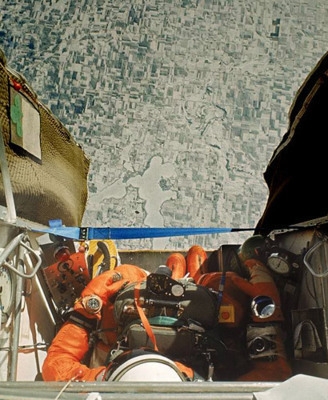Recommended Posts
riggerrob 643
Those minimums fell out of fashion a long time ago.
For example USPA's minimum opening altitude (i.e. show a pilot chute) of 2,000 feet for senior license holders was written back circa 1980 when the sport was transitioning from round to square canopies.
Fashion has moved on, setting higher standards (pun intended). Now freeflyers routinely toss their pilot chutes closer to 3,000 feet.
These days, if I am not "saddled out" by 2,500 feet, I mentally "kick" myself.
IOW If you have to argue about a hundred feet - close to USPA minimums - you sucked it waaaaaay too low.
QuoteIOW If you have to argue about a hundred feet - close to USPA minimums - you sucked it waaaaaay too low.
I've been "legal" and seen 1200 feet on my neptune. It's not always a difference of just a few hundred feet.
Dave
Orange1 0
Quote[The USPA BSRs list container opening altitudes. Most electronic devices record canopy deployment altitude. Two different things.
Interestingly, in SA our BSRs do actually list deployment altitude: "Except on demonstration jumps every parachutist shall ensure that his main canopy is fully inflated not lower than 2200ft above ground level.
Out of interest, are there any other countries out there who do as well?
jacketsdb23 49
QuoteWe can argue numbers all day, but the bottom line is that BSRs set "minimums."
Those minimums fell out of fashion a long time ago.
For example USPA's minimum opening altitude (i.e. show a pilot chute) of 2,000 feet for senior license holders was written back circa 1980 when the sport was transitioning from round to square canopies.
Fashion has moved on, setting higher standards (pun intended). Now freeflyers routinely toss their pilot chutes closer to 3,000 feet.
These days, if I am not "saddled out" by 2,500 feet, I mentally "kick" myself.
IOW If you have to argue about a hundred feet - close to USPA minimums - you sucked it waaaaaay too low.
I think what you said is important to note for all newer jumpers. I jump a crossfire 2 and pulled at 2200 on a recent "hop n' pop" load (I use that term loosely as I had reached terminal). When my canopy was finally opened my Neptune read 1150. I didn't violate a BSR. I did violate common sense. Todays canopies need to be opened higher for a lot of reasons:
1. Some are "eliptical" - line twists become malfunctions
2. They take longer to open (800ft or more is not uncommon)
2. We have a lot more to deal with after opening:
A) collapse slider, loosen chest strap, take off booties
B) Figure out where the rest of the 23 people on the load are
C) Fit yourself into a landing pattern (that begins immediately after opening - not at 1000ft.)
D) Avoid swooper lanes, or get yourself over to a swoop lane
[Feel free to add to the above list - these are just off the top of my head.]
Put it all together and the BSR requirement of a container opening by 2000ft for C & D license holders is no longer valid and paradoxically is no longer safe.
Marcel
God is Good
Beer is Great
Swoopers are crazy.
labrys 0
QuotePut it all together and the BSR requirement of a container opening by 2000ft for C & D license holders is no longer valid and paradoxically is no longer safe.
I don't think it's unsafe as a minimum. I think that the USPA is giving C and D license holders the opportunity to make their own choices. By that level someone should have the common sense to add altitude if they need to. Slow opening canopy... add altitude. Collapsable slider... add altitude.... on a large load.... add alti, etc.
The USPA also gives us no wind limits and that's "unsafe" too. But for now, it's still a matter of choice.
jacketsdb23 49
God is Good
Beer is Great
Swoopers are crazy.
denete 3
You're still pretty much at terminal when you hit line stretch (at least in the eyes of your recording altimeter), unless you're jumping a BASE rig. So, you should consider almost all of your snivel to still be part of your freefall unless you've significantly slowed down and your altimeter passes a data recording point.
(old people should now begin to discount the statements above)
(insert typical disclaimers here)
- David
"our attitude is the thing most capable of keeping us safe"
(look, grab, look, grab, peel, punch, punch, arch)
jsaxton 0
Quote
I don't think it's unsafe as a minimum. I think that the USPA is giving C and D license holders the opportunity to make their own choices. By that level someone should have the common sense to add altitude if they need to. Slow opening canopy... add altitude. Collapsable slider... add altitude.... on a large load.... add alti, etc.
EXACTLY!
The safe minimum pack opening altitude will depend on the type of jump.
denete 3
FWIW, I get about 650' difference between dump and the first canopy flight data point.
"our attitude is the thing most capable of keeping us safe"
(look, grab, look, grab, peel, punch, punch, arch)
QuoteFWIW, I get about 650' difference between dump and the first canopy flight data point.
At your fall-rate, that would be a hard opening...I mean, like 1 second.
(FWIW, that translates to 443 miles per hour.)
I think we're all Bozos on this bus.
Falcon5232, SCS8170, SCSA353, POPS9398, DS239
pchapman 279
USA "pack opening altitude"
UK "opening" (with some variation in interpretation)
In Canada for the CSPA it is the minimum altitude at which the "parachute must be activated".
"Activated" could be interpreted different ways, whether it is first starting to pull the PC (only starting to activate it), or perhaps better, letting go of the PC.
when do you guys go for the PC!?
-Hunter S. Thompson
"No. Try not. Do... or do not. There is no try."
-Yoda
damion75 0
Quote
UK "opening" (with some variation in interpretation)
I'm not seeing a lot of variation in interpretation from the Ops Manual...
From the BPA Ops Manual, Section 8:
Quote
4. OPENING HEIGHTS
Minimum opening heights for main parachutes:-
This clearly states main canopy opening. Not p/c throw, release or opening, and not container opening or linestretch. Just the altitude at which the main canopy must be opening.
Incidentally, I would be interested to know ballpark how much altitude a main canopy takes to 'open' from the moment it leaves the D Bag (obviously not therefore to include the altitude lost during pc toss and DBag deployment). Anyone? Bueller? Anyone?
Not one shred of evidence supports the theory that life is serious - look at the platypus.
Quote
Incidentally, I would be interested to know ballpark how much altitude a main canopy takes to 'open' from the moment it leaves the D Bag (obviously not therefore to include the altitude lost during pc toss and DBag deployment). Anyone? Bueller? Anyone?
There is very little difference between setups in how long it takes the pilot chute to inflate, open the container, extend to linestretch, open the bag and remove the bag. The efficiency of the pilot chute and the length of the lines would be the only real variations in the sequence from pitch to bag removal, it takes about a quarter of a second to remove 2 feet from the stows, and if you are getting alot of hesitation from your pilot chute, then it needs to be replaced.
The canopy inflation is where the variation comes from. Some canopies like to fully inflate very quickly once they're introduced to the air (sabre, lightning, etc).. Other canopies like the velocity, katana, etc all have a little song and dance they like to do during the inflation sequence.
Pulse 0
Also, some sense has to be involved here. USPA states that the decision to cutaway should be made by 1,800 feet and actions should be taken by 1,600 feet. Is this really acceptable with a minimum pack-opening of 2,000 feet? Then again. I've heard jumpers talk about being open at 1,500 feet and saying, "But I pulled at 3,500." As though that is acceptable. They should have been under their reserve by 2,000 feet in that instance.
It makes me wonder, when does it become a malfunction?










I tried to win that argument on a coach eval once... Evaluator said I pulled under 3,500 which is an automatic failure. I knew I pulled higher than that, but my only proof was a neptune that showed I pulled at 3,200 or something. Had I pulled under 3,500, it would have shown under 3,000... but that argument didn't work so well...
Dave
Share this post
Link to post
Share on other sites